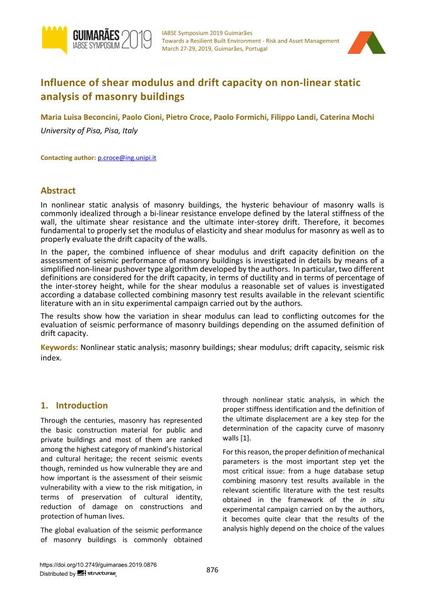Influence of shear modulus and drift capacity on non-linear static analysis of masonry buildings

|
|
|||||||||||
Bibliografische Angaben
| Autor(en): |
Maria Luisa Beconcini
(University of Pisa, Pisa, Italy)
Paolo Cioni (University of Pisa, Pisa, Italy) Pietro Croce Paolo Formichi (University of Pisa, Pisa, Italy) Filippo Landi (University of Pisa, Pisa, Italy) Caterina Mochi (University of Pisa, Pisa, Italy) |
||||
|---|---|---|---|---|---|
| Medium: | Tagungsbeitrag | ||||
| Sprache(n): | Englisch | ||||
| Tagung: | IABSE Symposium: Towards a Resilient Built Environment Risk and Asset Management, Guimarães, Portugal, 27-29 March 2019 | ||||
| Veröffentlicht in: | IABSE Symposium Guimarães 2019 | ||||
|
|||||
| Seite(n): | 876-883 | ||||
| Anzahl der Seiten (im PDF): | 8 | ||||
| DOI: | 10.2749/guimaraes.2019.0876 | ||||
| Abstrakt: |
In nonlinear static analysis of masonry buildings, the hysteric behaviour of masonry walls is commonly idealized through a bi-linear resistance envelope defined by the lateral stiffness of the wall, the ultimate shear resistance and the ultimate inter-storey drift. Therefore, it becomes fundamental to properly set the modulus of elasticity and shear modulus for masonry as well as to properly evaluate the drift capacity of the walls. In the paper, the combined influence of shear modulus and drift capacity definition on the assessment of seismic performance of masonry buildings is investigated in details by means of a simplified non-linear pushover type algorithm developed by the authors. In particular, two different definitions are considered for the drift capacity, in terms of ductility and in terms of percentage of the inter-storey height, while for the shear modulus a reasonable set of values is investigated according a database collected combining masonry test results available in the relevant scientific literature with an in situ experimental campaign carried out by the authors. The results show how the variation in shear modulus can lead to conflicting outcomes for the evaluation of seismic performance of masonry buildings depending on the assumed definition of drift capacity. |
||||
